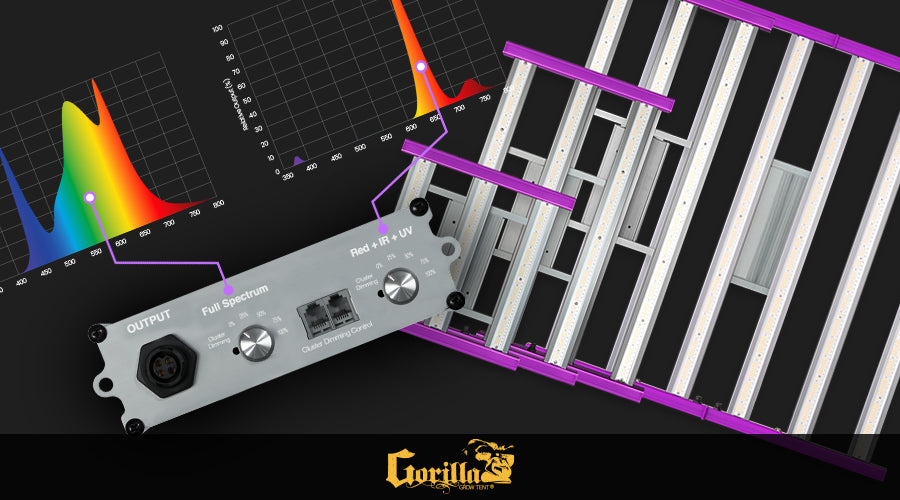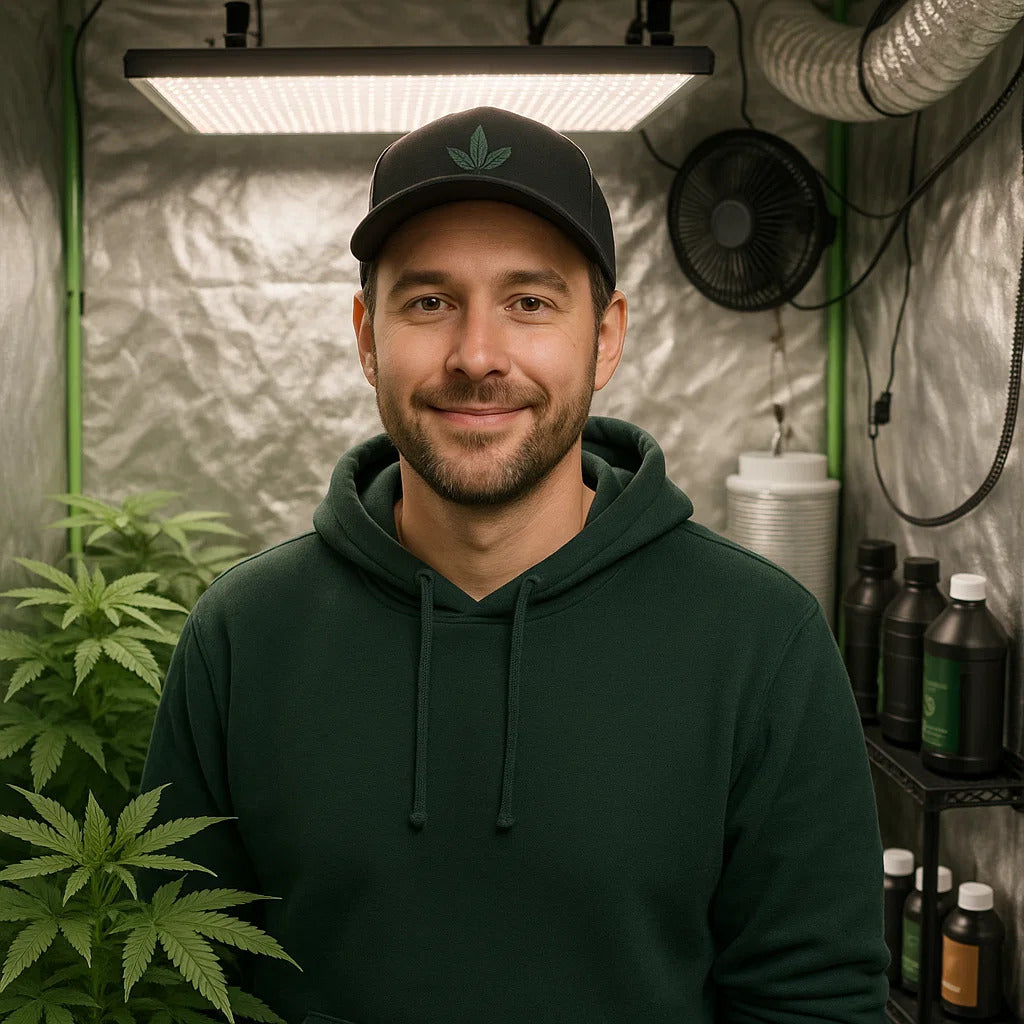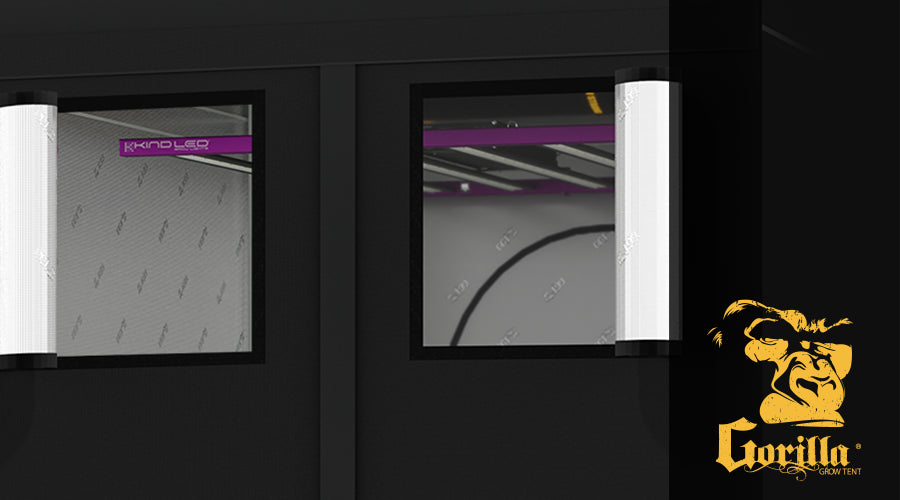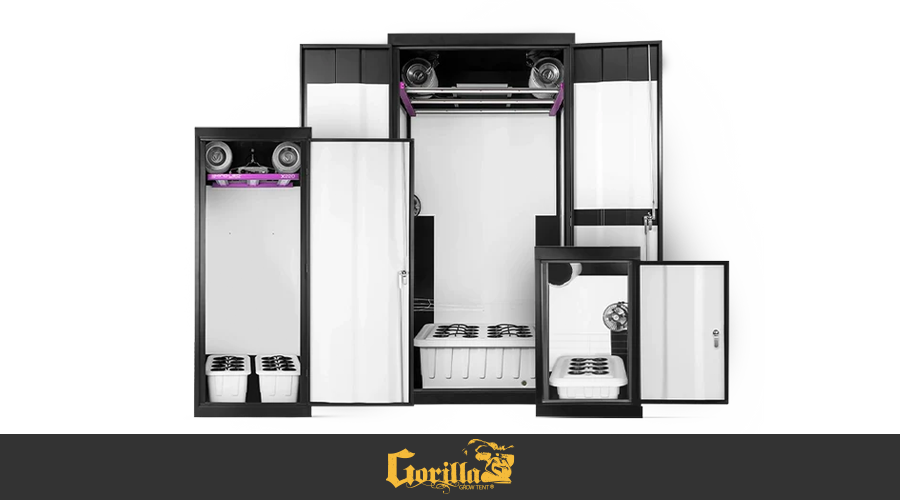
The Advantages of LED Lighting for Plants to Grow
Illuminating Growth: The Advantages of LED Lighting for Plants to Grow
As plant enthusiasts, we understand light's critical role in the growth and development of our leafy companions. While sunlight remains the most natural and abundant light source, technological advancements have introduced a new contender in plant illumination: LED lighting.
In this article, we will explore the fascinating world of LED lighting for plant growth, shedding light on its benefits, considerations, and how to leverage this technology to optimize indoor gardening endeavors.
How LED Lighting Revolutionizes Indoor Gardening
The Power of LED Lighting
LEDs (Light-Emitting Diodes) have revolutionized the lighting world due to their energy efficiency, long lifespan, and ability to emit specific wavelengths of light. When it comes to plants, LEDs offer several advantages:
Tailored Spectrum: LED lights can be customized to emit specific wavelengths of light, allowing growers to fine-tune the light spectrum according to the needs of different plant species and growth stages. This level of control promotes optimal photosynthesis and overall plant health.
Energy Efficiency: LED lighting is highly energy-efficient, converting significant electrical energy into light while minimizing heat production. This efficiency results in lower electricity bills and reduces the risk of scorching or damaging plants due to excessive heat.
Longevity: LEDs boast an impressive lifespan, surpassing traditional lighting options such as fluorescent or incandescent bulbs. With minimal degradation over time, LED lights can provide consistent and reliable illumination for plants throughout their lifespan.
Choosing the Right LED Lighting
When selecting LED lighting for your plant growth needs, consider the following factors:
Light Spectrum: Different wavelengths of light affect plant growth. Red light promotes flowering and fruiting, while blue light encourages vegetative growth. Full-spectrum LEDs incorporating red and blue wavelengths offer a balanced approach suitable for most plants.
Light Intensity: The intensity required depends on the plant species and growth stage. Seedlings and young plants generally require lower light intensity, while mature plants need more intense illumination. Ensure your LED lighting setup provides the appropriate intensity to match your plants' requirements.
Coverage Area: Consider the size of your growing space and choose LED lights that can adequately cover the area. Manufacturers typically provide information regarding the coverage area for their products, helping you select the right size and quantity of LED lights.
Implementing LED Lighting for Optimal Plant Growth
To maximize the benefits of LED lighting for your plants, follow these essential tips:
Positioning: Place LED lights at the appropriate height and angle to ensure even coverage and prevent shadows. Maintain a safe distance to avoid heat damage, as LEDs emit less heat than traditional lighting options.
Duration and Timing: Each plant has specific lighting requirements for duration and timing. Most plants need around 12-16 hours of light daily for healthy growth. Invest in a timer or smart lighting system to automate the lighting schedule and ensure consistency.
Monitor Plant Response: Observe your plants closely and adjust as needed. If plants show signs of light stress (e.g., leaf discoloration or wilting), adjust the light intensity or duration accordingly.
The Future of LED Lighting in Plant Cultivation
LED lighting technology continues to advance, offering even greater potential for indoor gardening and commercial plant cultivation. Researchers are exploring the effects of additional light wavelengths on plant growth, such as ultraviolet (UV) and infrared (IR). These advancements may unlock new possibilities for crop yield optimization, disease prevention, and nutrient absorption.
With advancements in LED technology on the horizon, we can anticipate even more exciting possibilities for indoor gardening and agricultural practices.
So, whether you're a hobbyist looking to nurture a thriving indoor garden or a commercial grower aiming to maximize yields, harnessing the power of LED lighting will undoubtedly illuminate the path to successful plant cultivation.
Let There Be Light: The Role of UV Light in Plant Growth
When it comes to plant growth, light plays a crucial role. We often associate plants with sunlight, which provides the energy necessary for photosynthesis. However, not all light is the same, and one particular type of light that often raises questions is ultraviolet (UV) light.
The Truth About UV Light and Plant Health
UV light is a part of the electromagnetic spectrum that ranges from 10 to 400 nanometers (nm) in wavelength. It is classified into three types: UVA (315-400 nm), UVB (280-315 nm), and UVC (100-280 nm). The ozone layer in the Earth's atmosphere absorbs most of the harmful UVC radiation, while UVA and UVB reach the surface to varying extents.
The Effects of UV Light on Plants
Photomorphogenesis:
Plants have specific photoreceptors that detect different wavelengths of light. While UV light is not a primary factor in plant growth, it can influence photomorphogenesis, which is the developmental response of plants to light. UV light exposure can affect various plant processes, including seed germination, leaf expansion, flowering time, and the production of secondary metabolites.
Pigment Production:
UV light can stimulate the production of certain pigments in plants. For example, flavonoids and anthocyanins, responsible for the vibrant colors in flowers and fruits, often increase in concentration when plants are exposed to UV light. These pigments contribute to the plant's aesthetic appeal and act as natural sunscreens, protecting plant tissues from excessive UV radiation.
Defense Mechanisms:
UV light can act as a stressor for plants, triggering defense mechanisms. When exposed to UV light, plants may produce various compounds, such as phenols and antioxidants, to counteract the harmful effects of UV radiation. These compounds help mitigate damage caused by free radicals and prevent DNA mutations.
Adaptation:
Some plants, especially those native to high-altitude regions or areas with low atmospheric ozone levels, have evolved to tolerate or utilize higher levels of UV light. These plants have developed protective mechanisms, such as thicker cuticles, increased production of UV-absorbing compounds, and altered DNA repair mechanisms, to survive and thrive under these conditions.
Exploring the Benefits and Risks of Ultraviolet Light for Plants
Do Plants Need UV Light?
While UV light has some effects on plants, it is important to note that it is not essential for their growth and development. Plants can grow perfectly fine without exposure to UV light. Excessive exposure to UV radiation can harm plant health, causing DNA damage, leaf burns, and reduced growth.
Artificial Lighting and UV for Indoor Gardening
In indoor gardening or controlled environment agriculture, growers often use artificial lighting to supplement or replace natural sunlight. While most artificial grow lights do not emit significant amounts of UV light, some specialized UV LED lights are commercially available. These UV lights are primarily used for research or specific applications like UV disinfection in hydroponic systems. However, for general plant growth, the absence of UV light in artificial lighting does not impede plant development.
It's important to note that UV light can also harm humans and other animals. Prolonged or intense exposure to UV radiation can lead to sunburn, skin damage, and an increased risk of skin cancer. When using artificial lighting for indoor gardening, it's crucial to prioritize the safety of plants and humans by selecting lights emitting minimal UV radiation.
Remember, always prioritize the well-being of your plants and consider their specific light requirements when setting up artificial lighting systems. By understanding the role of light in plant growth and providing the necessary conditions, you can create an optimal environment for your plants to thrive and flourish, even without UV light.
Shedding Light on the Importance of Red Light for Plants
When we think about plants, sunlight is often the first thing that comes to mind. But did you know that not all light colors are equal in plant growth and development? One particular color that plays a crucial role in the life of plants is red light.
In this article, we will explore the significance of red light for plants and how it influences their growth, photosynthesis, and flowering processes.
Unleashing Nature's Rosy Secret: The Role of Red Light in Plant Growth
Red light is part of the visible spectrum, with a wavelength range of approximately 620 to 750 nanometers. Plants have evolved to respond to and utilize different wavelengths of light through specialized pigments called photoreceptors. The primary photoreceptor involved in the detection of red light is called phytochrome.
Photosynthesis and Red Light
Photosynthesis, the process by which plants convert light energy into chemical energy, is heavily influenced by red light. The chlorophyll pigments in plant cells primarily absorb red and blue light, which is particularly important for energy conversion.
Red light stimulates the production of ATP (adenosine triphosphate), the primary energy currency of cells, and NADPH (nicotinamide adenine dinucleotide phosphate), an essential molecule for synthesizing carbohydrates during photosynthesis. This influx of energy allows plants to carry out the biochemical reactions necessary for growth and development.
Effects on Plant Growth
Red light is known to impact various aspects of plant growth significantly. When exposed to abundant red light, plants exhibit elongated stems, a phenomenon known as "etiolation." This response is due to the plant's attempt to reach for more light in low-light conditions.
In contrast, insufficient red light can lead to stunted growth and pale, weak plants. Without an adequate supply of red light, plants may struggle to undergo essential processes like cell division, elongation, and differentiation. Therefore, providing plants with the right balance of red light is essential for healthy growth.
Flowering and Red Light
Red light plays a crucial role in regulating the flowering process in many plants. Phytochrome, the red light photoreceptor mentioned earlier, controls the timing of flowering by sensing the duration of daylight and darkness.
Certain plants, such as long-day plants, require a specific amount of darkness to trigger the flowering process. Red light can deactivate the phytochrome molecule, allowing plants to "sense" the duration of darkness accurately. Once the optimal period of darkness is reached, the plant receives the signal to initiate flowering.
Influence of Red Light on Morphogenesis
Besides promoting growth and flowering, red light also influences other aspects of plant development, including morphogenesis. Morphogenesis refers to developing a plant's overall shape, structure, and form.
Red light has been shown to affect various morphological traits such as leaf expansion, root growth, and branching patterns. By manipulating the intensity and duration of red light exposure, growers and researchers can influence these traits and guide the desired growth patterns of plants.
Whether you're a hobby gardener or a professional horticulturist, ensuring that plants receive adequate red light can enhance their health, productivity, and aesthetic appeal.
The Botanical Brilliance: Unveiling the Influence of Blue Light on Plant Growth
Plants, like humans, have a unique relationship with light. While sunlight is essential for photosynthesis, recent research has shed light on the specific wavelengths of light that can significantly impact plant growth and development. One such wavelength, blue light, has emerged as a fascinating topic of study in plant biology.
Blue light, despite its relatively short wavelength, holds immense significance in the life of plants. Its effects on growth patterns, morphology, and flowering make it an indispensable tool for optimizing plant cultivation.
In this article, we will explore the effects of blue light on plants and uncover its potential implications for optimizing indoor cultivation and sustainable agriculture.
The Blue Light Revolution: Illuminating the Secrets of Plant Biology
Blue light refers to the high-energy, short-wavelength light that falls within the 400 to 500-nanometer range of the electromagnetic spectrum. In nature, blue light is prevalent during the daytime and is responsible for influencing various plant processes, including photomorphogenesis, chloroplast movement, stomatal regulation, and the synthesis of photoreceptors.
Role in Plant Growth
Blue light plays a crucial role in shaping plant growth and development. One of its primary effects is its impact on phototropism, the growth or movement of plants in response to light. Studies have shown that blue light can induce positive phototropism, leading to the upward bending of plant stems and directional growth toward a light source.
Furthermore, blue light influences leaf expansion, chlorophyll synthesis, and the opening and closing of stomata. These effects are mediated by photoreceptors called cryptochromes and phototropin, which absorb and respond to blue light. Cryptochromes regulate various physiological processes such as seed germination, photoperiodic flowering, and the control of circadian rhythms.
Effects on Morphology
In addition to its influence on growth patterns, blue light also affects the morphology of plants. Experiments conducted with a high proportion of blue light in indoor cultivation have revealed plants with shorter internodes, denser foliage, and increased biomass. These morphological changes can have profound implications for commercial growers aiming to optimize yield and quality.
Regulation of Flowering
Blue light is intimately involved in regulating flowering in many plant species. The transition from the vegetative to the reproductive phase is tightly controlled by photoperiod, the duration of light, and darkness. By sensing the blue light component of the light spectrum, plants can accurately perceive the length of the day and initiate the flowering process accordingly. This information is vital for greenhouse operations and growers who want to synchronize flowering across different plant varieties.
Supplementing Indoor Lighting
The increasing demand for year-round and sustainable food production has increased indoor cultivation. Growers employ artificial lighting systems to mimic natural sunlight, including light-emitting diodes (LEDs). LEDs have the advantage of being highly controllable and energy-efficient, making them a popular choice for indoor farming.
Growers can manipulate plant growth and development by fine-tuning the light spectrum emitted by LEDs. Increasing evidence suggests that the optimal blue-to-red light ratio can enhance photosynthetic efficiency, promote compact growth, and influence plant metabolism. The controlled application of blue light can lead to improved plant quality, increased yield, and shortened growth cycles, thus revolutionizing modern agriculture.
As we delve deeper into the science of blue light and its interaction with plant biology, we unlock new possibilities for sustainable agriculture and indoor farming.
Happy gardening!

Lena Myles
I'm a mushroom enthusiast and home cook based in Oregon. I'm passionate about foraging and creating fungi-focused recipes, especially delicious, plant-based dishes using gourmet mushrooms like trumpet, shiitake, and oyster. When I’m not in the kitchen, you’ll usually find me wandering the woods in search of new wild flavors.



